Using Mold Plates (The Right Way) to Monitor Indoor Fungal Load and Protect Your Health
Every since I started this blog, I have been sharing the many ways I use inexpensive mold plates to test the air and different pieces of furniture and/or belongings in our home for mold. I use these plates to keep a constant eye on mold levels and to make sure our exposure is not increasing unchecked. I also like to use the plates when I am experimenting with different ways of cleaning things to make sure I am bringing spore levels down. I like having some way to measure BEFORE and AFTER and some barometer of what is there at a specific snapshot in time to rule environmental mold out as the cause for any inflammatory symptoms or autoimmune flares (I acquired ulcerative colitis during my battle with mold toxicity) that I sometimes still experience. There is always a strong correlation for me with my health status and the fungal load in our home now that my body has become sensitized to mold. My threshold for all environmental toxins is now much lower and even a little mold exposure can be a LOT for my body these days if you know what I mean.
What is Fungal Load and Why Should You Care?
“Fungal load” is a term that I got from Dr. Dennis and is used when he is discussing fungal infestation in a patient and his/her environment. Allowed to go unchecked in the body or environment, fungi can and usually do replicate–make copies of themselves–which causes the overall amount of fungi or fungal load to increase. That is why keeping the fungal load low in your home can help you to maintain your health. Counting the mold colonies that form on a mold plate after testing the air or after testing clothing or belongings does just that–measures, in a rudimentary but straightforward way, the immediate fungal load at that point in time.
After treating thousands of patients with allergic fungal sinusitis, Dr. Dennis began testing their clothing and nasal cavities for fungus in his office. He found that the high levels of mold spores on their clothing were directly related to the species of mold also found to be inflaming and causing infection (chronic infection for many) in their sinus cavities. Further, when he sent those same patients home with mold test plates to also test the air in their homes, they found high indoor mold counts or a high fungal load in the rooms in their homes where they spent the most time. It was a correlation (high environmental mold equals increased instance of chronic sinusitis) confirmed by more in-depth environmental and mycotoxin testing, but an undeniable correlation nonetheless, and one that he was able to chart and track overtime clinically to come up with some pretty solid guidelines for his patients as far as mold plate testing is concerned. It is Dr. Dennis’s guidelines from which I base my own baselines when I monitor my home today. (Keeping the mold counts in the air and on belongings at 0-4 colonies is ideal for continued health and recovery.)
Why Test at All With Mold Plates?
Let’s not beat around the bush–mold plate testing is definitely not the beat-all-end-all diagnostic for an indoor mold problem; gravity test plates should not be “the tool of choice” or used as the only gauge for whether a home has a mold problem or is “safe” or not. They are just an easily accessible, inexpensive option for someone wanting–
1.) To see IF their home and/or belongings have elevated levels of mold,
2.) To see WHERE or in what areas or rooms those elevated levels of mold might be, or
3.) To obtain a fungal load baseline so that a mold-sensitive person can monitor their environment.
I use mold plates for #3, and they work well for that purpose at a price that doesn’t break the bank. Then, if I suspect a larger problem, or see trends of an elevated fungal load in the air or on our belongings that do not decrease with normal cleaning and mold maintenance, I can do and ERMI or mycotoxin testing or can call an indoor environmental professional to help me diagnose and solve the problem before it gets out of control and/or wrecks my health.
How I Use Mold Plates
In order to help you understand the most effective ways to use the mold plates for screening your air and belongings, I thought I would share a very simple “how-to” on how I use them in my home. I will walk you through using the mold plates to test your air and to TAP test your things. I will also share links to further testing methods like mycotoxin and ERMI test kits and professional inspection resources that can be used to find out your potential exposure risk in your current environment to the more toxic and water-damage indicating molds.
Using Mold Plates for Air and TAP Testing
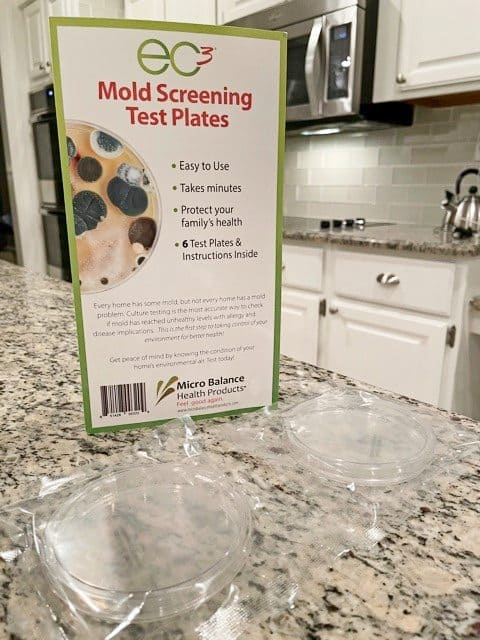
I have found that in order to stay well, I need to keep mold plate counts at 0-4 colonies per plate with a 1-hour plate exposure for air testing and 0-4 colonies per plate for any TAP test performed on my belongings/clothing/furnishings. This is key for me and my body. I am not making any claims or assumptions for anyone else here. This is just a guideline. Unless my indoor environments are kept at this level, nothing else works long term for me. I must breathe clean air in order to get well and to stay well. Period. You could definitely be different, but, if you are mold sensitive, you are likely going to need to keep things at a similar level.
(Note: To obtain the most accurate information possible, you will also need to record the humidity in each area tested. If the humidity is higher than 50%, any ambient mold spores that are inside your home will have the level of moisture needed to land and proliferate. This is also why cleaning with mold-specific products, keeping dust to a minimum, and HEPA vacuuming can be so important to maintaining your home and your health.)
Performing a 1-Hour Air Test:
Preparation: I like to refrigerate my mold plates upon receipt and use them as soon as possible. Pay special attention to the expiration dates and do not use expired plates when testing. Do not open the mold plates until you are ready to use them. Keep windows closed for six hours prior to testing.
Do what you normally do. For example, do not turn on the air conditioning unless that is part of your normal activity. However, DO place the central fan on the heating and air conditioning system in the “on” position. Do not sweep or vacuum just before the test since this activity can increase the number of mold spores that are in the air. Children and pets can continue to be in the areas being tested, but do NOT allow them to touch the materials. The main thing is to ACT NORMALLY. Select an area to place the mold plate that is at least 3 feet from a wall. Use a humidity gauge to test the humidity in each area. If humidity is really high (60% or above), you will need to disturb the air in the room a bit to get mold spores to become airborne. High humidity will cause them to stay on top of surfaces. There are also many types of mold that are not culturable on mold plates. Go into this process knowing this. You are getting a snapshot of what is there. You are NOT getting the big picture.
Suggested Areas for Sampling: Locate the area or areas that you wish to test. If specific areas cause sneezing and coughing, or noticeable symptoms, they should be included. At a minimum, please be sure that at least one mold plate is placed in each of the following areas:
■ Attic ■ Basement ■ Master Bedroom ■ Den/Great Room ■ Car ■ Kitchen ■ Child’s Bedroom ■ Office (home & work) ■ Other active rooms – In large homes, place 2 plates in the basement & attic
It is not necessary to place mold plates in rooms that are not used. It is necessary to place plates in rooms that have odors–musty especially, if symptoms occur in that room, or if there is a history of water damage in that room. Do not place any mold plate in direct sunlight. When I test our home, I typically air test all of our bedrooms, the kitchen, living room, and the attic.
Directions for Air Testing:
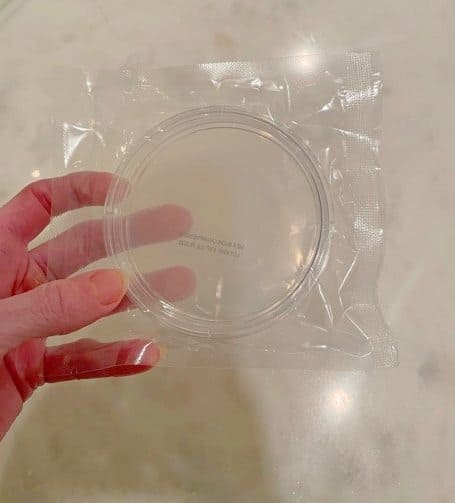
1. Carefully unwrap the materials. Do not touch the inside of the test plates.
2. Place the plate on a tissue or paper towel in the room you wish to test. The top should be up and is the larger side of the test plate.
3. Lift the top straight up. Place the top on the tissue with the inside surface down. Do not turn the top upside down.
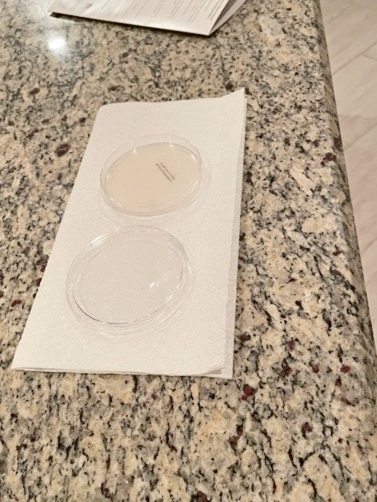 4. Allow the plate to sit open for one hour.
4. Allow the plate to sit open for one hour.
5. Put the top back on the plate. Tape the top closed.
6. Write the name of the room, the humidity level, and the date on the bottom of the plate with a permanent marker that writes on plastic. Use descriptions like attic front, attic back, master bedroom, downstairs playroom, crawl space, etc., so the results can be easily tied back to the correct areas of your house. (Note: If you do not have a humidity sensor on your thermostat, you can purchase a hygrometer from Amazon or Home Depot. Here is one I like that is very inexpensive.)

7. Wrap everything in aluminum foil. Several plates can be wrapped together.
8. Place wrapped plates in a warm, dark spot, such as a kitchen drawer for 4 days. (Note: My 4-day incubation period guideline may be shorter than what is advised with some test plates. I find 4 days to be the ideal time for allowing the mold colonies to grow. Just make sure not to forget about them!)
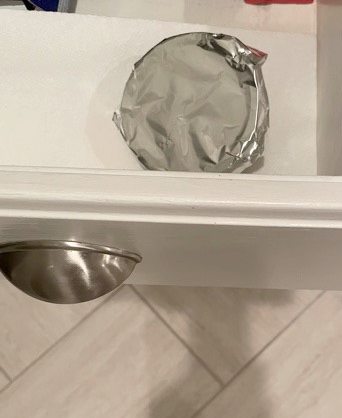
9. On the 4th day, unwrap but do NOT open the plates. Count the circular colonies present on each plate. Each circle represents a mold colony. You ideally want to have fewer than 4 on each plate. Here are some examples of mold tests I have done recently in our home with acceptable results:
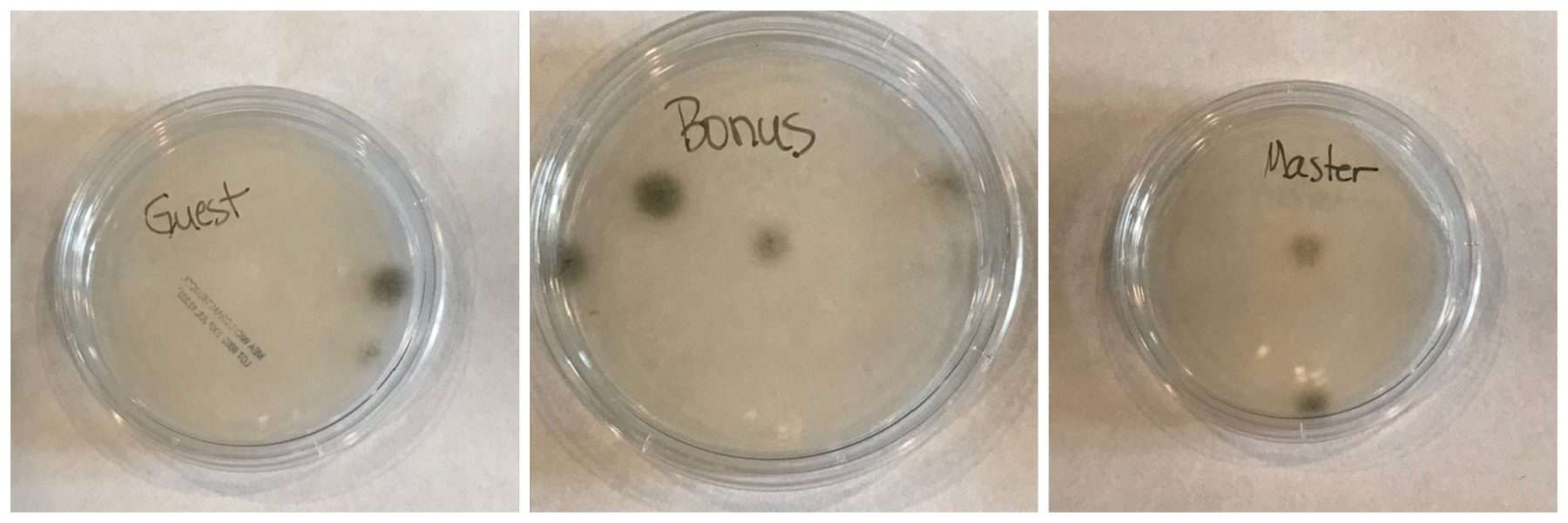
Slight aside–What is so interesting to me that I can share with you is that my daughter does her sewing in the bonus room. I am constantly vacuuming and dusting in there and devising better ways to store fabrics and material for her products because they naturally harbor mold. It was no surprise to me that the bonus room was a bit elevated, but was not bad. Just a reminder that vigilance and mold maintenance can allow us to do the things we love, but still live a normal, healthy life.
Below is an example of a friend’s TAP test plate with unacceptable results due to some contaminated carpet in a bedroom that needed to be removed–this picture is courtesy of Erin Porter from Eat, Pray, Get Well. If you have never checked her blog out, you should! She is fantastic and shares wonderful articles and recipes all geared towards avoiding mold:
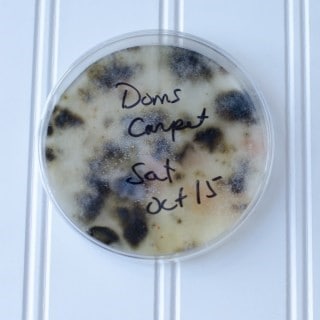
But, this is also the reason why you test the air AND TAP test–which I will explain in a minute. Because if just the air in this room had been tested, the mold counts would have likely been higher, but by ALSO TAP testing the carpet, the homeowner knew WHY and then could know WHAT to remove or fix to make the home healthier.
Directions for TAP Testing:
You will tap certain items, by opening the test plate and tapping the item with the media surface pointed down towards the item you are tapping.
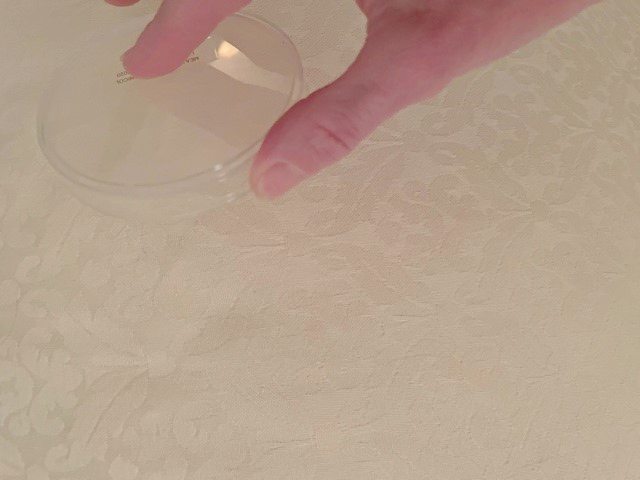
The following items should be tapped for the clearest picture of fungal load:
■ Mattresses and Pillows ■ Carpet or Rugs that have frequent traffic ■ Clothes in your closet that you wear and wash frequently ■ Furniture that you sit in the most in your home ■ Pets ■ Desk or work table or area ■
Once complete you will follow the instructions above #’s 5 through 9. Make sure to label each plate accurately for the item tested. Again, the goal for mold-sensitive folks is to achieve test plates that only grow 4 colonies of mold per item in four days incubation time.
Digging Deeper
If you perform this type of testing and find that your indoor fungal load is elevated and feel that you have not pinpointed a reason, unlike the carpet example I shared above, I always suggest doing some deep cleaning, humidity control, and increased air filtration/purification. If a home does not have water damage or intrusion, this can sometimes be enough. If levels continue to increase despite cleaning and mold maintenance interventions, you will need to contact a qualified indoor environmental inspector (good resources are the American Industrial Hygiene Association, the ACAC, ISEAI and the IICRC websites) or a certified Building Biologist to help you get to the root of the issue. You can also choose to go deeper with diagnostic testing like the ERMI, EMMA, or Mycotoxin testing. I do recommend contacting a professional first, though, to assist you in devising a testing strategy so that you not only come up with test results but also with a strategic game plan of how to fix the underlying issues causing the elevated mold growth and indoor fungal load and a clear, effective remediation strategy for your indoor air and belongings once those fixes are complete.


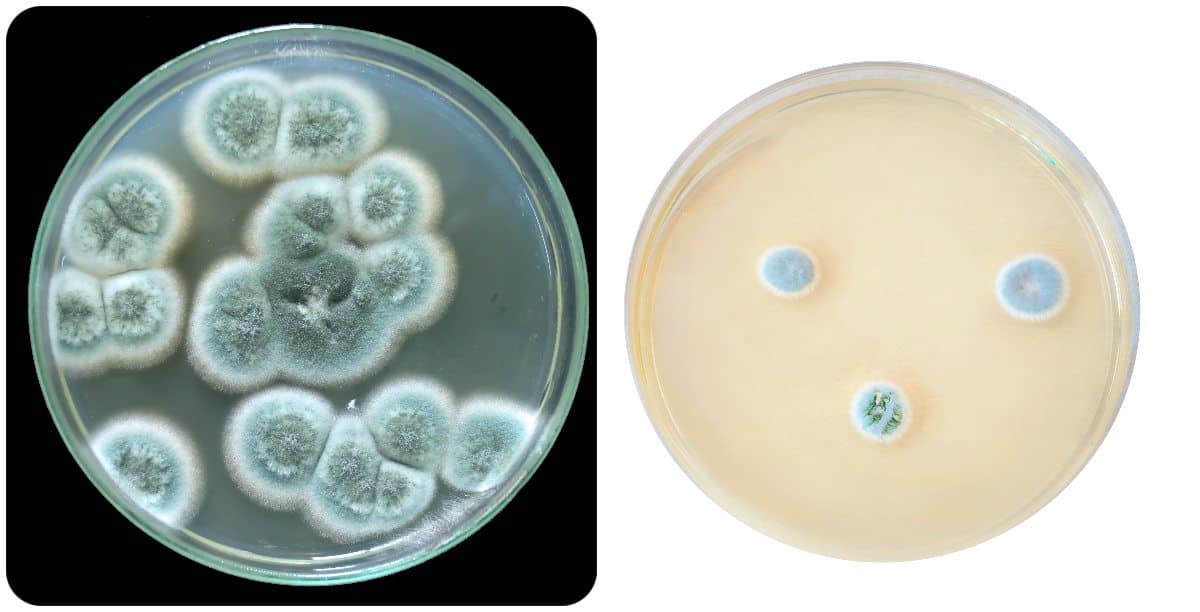
16 comments
I did an air petri dish test in my bathroom prior to reading your blog but did not cover the petri dish in foil. Also, the directions said to let it sit for only 4 days (as opposed to 5) Will these factors impact my results?
Hi, Rachel,
I would always follow whatever directions come with your mold plates to the letter. If you followed those directions, I would assume your results would be accurate. I cannot speak to other testing plates, though, since the ones I use are the EC3 Mold Screening Test Plates. I do know that foil creates a dark environment so encourages the mold to grow. Also the 5 day incubation period is to give it enough time to give you a decent read of what is there.
Hi Catherine — I appreciate your site — it’s been formative for me as I figure out how to manage my living environment.
I’m finding that every 1-2 days of culture time, new colonies keep appearing. For example, one plate showed only three colonies after four days. I decided to let them go longer because the temperature had been a little lower than optimal (70-72F). A day or two later I saw two new tiny specs appear. Now two days later, those specs are growing into colonies, and there are 3-4 new tiny specs! It seems likely that if I wait two more days, those 3-4 will grow into colonies as well, and maybe even more specs will appear.
I’d assumed the choice of waiting four days vs. 6-7 was simply to let the colonies grow large enough to be visually counted. But now it seems to dictate whether I see three, nine, or ?? colonies. If I’d stopped at four days, I would’ve gotten a much lower count.
So are these newer colonies “legitimate”? Where are they coming from? I’ve wondered if they’re actually spreading within the plate from the original colonies, and thus not reflective of the room-under-test — maybe because I turned the plates upside down while handling them? Yet these plates get shipped to labs all the time, so that doesn’t seem to be it.
Thank you.
Hi, Vance,
I would suggest always, always following the directions. Once the 5-day mark hits, look at the plates, count your colonies, and understand that the 5-day grow time is designed as a snapshot of the fungal load for the purposes of diagnosing the environment tested. The agar is designed to grow mold, so the colonies will continue to form until the “food” in the agar runs out. Newer colonies are “legitimate” but not indicative of a worse conclusion about your environment. In other words, if you only have 3 colonies in five days, your fungal load is normal. If you have 8 in 5 days, it is elevated and there is something going on to cause that. Additional incubation will not give you a better answer. It will just give you additional colonies. I hope that makes sense.
We left our moldy home and are trying to buy a new house(not new construction). It’s a challenge. Most homes have visible mold. If they don’t, I’m doing plate tests with an ermi follow up but the plates are coming back with 6-10 colonies each. Does the color of the colony matter? Are white colonies less harmful than darker ones? Thank you
When you are doing plates, you are just counting colonies for fungal load. You really cannot look to the coloring on those, because that is not the intended purpose of the plates. The ERMI after should be what you rely on for species info. If the home has a high fungal load, then you definitely want to dig deeper to see if there is a mold species that indicates a water intrusion or moisture issue. I hope that makes sense.
Hi Catherine,
I know we have an issue in our floor ducts in the slab. We have not figured out if there is a leak or if its just excess moisture from groundwater. It’s a localized smell to 2-3 of our ducts. There is evidence of water in the past before we bought the house, but have not seen water ourselves. If we are able to get to the root of the moisture, what can we even do to clean out the mold down there? I know we can get a duct cleaning company but even they can only remove the dust, not what is attached to the PVC. Weve had several professionals out and no one seems able to find the foot cause and treat it, let alone get the mold out. Any advice is welcome!
The first order of business is definitely figuring out the source of the problem. I would not want you spending money on cleaning, etc. until you know what is causing the issue. After that, I would recommend replacing all affected ductwork and possibly replacing your mechanical system if it is causing the pooling of water or mold issue.
Hello! Do you leave your air cleaners and purifiers on during testing? Or if not how long before the test do you turn them off?
Thanks so much!
I turn them off. I wait about an hour and then test.
I have a mold problem and the landlord says she’s going to have our home tested but has not scheduled only test or even an inspection since I started asking her in January 2021. I am having an auto immune response as a rash, mainly my face arms and chest. My palms are red and tender and every time I touch anything with mold, they sting as if I was cutting hot peppers without gloves. My fiance cannot see any mold or my rashy skin, saying it’s just dirt. He’s becoming increasingly irrational and illogical, plus shows signs of dementia. Both of us have symptoms in the third tier of mold exposure and I’m past worry, I’m very scared for us. It’s been a year since we brought my vanity inside and we recently found out that my ex husband had mold in the storage unit but didn’t warn us it could be on the vanity. My fiance won’t believe me, disputing every thing I say, refusing to accept any proof except a medical verification. I can’t get Medicaid to cover the very expensive test without environmental proof. We are now overrun with a film of mold growing on every single surface, and worsening symptoms. I have an indoor air quality monitor that shows VOCs from mid to high levels, an indication that something needs to done to eliminate this problem. However, I cannot get our landlord to act. Is there any advice you can give or an agency I should call?
I purchased a air purifier with a UVC light and a UVC sanitation lamp, both work well in the battle but without professional mold removal, it’s just getting worse every day. I did discover that an apple cider vinegar pill, meant for indigestion, works wonders for the symptoms I am experiencing, including but not limited to: rash/skin irritation, fatigue, sleeplessness, restlessness, kidney function and mood. I noticed how quickly it relieved the rash and realized how bad my kidneys had been by the improvement in frequency and strength of urination stream. Please pray for us to get the help we need and we’ll keep praying for all of those affected by those terrible spores.
Thank you for this wonderfully informative website.
Hi, Dawn,
I would look up renter’s rights or law regarding rental properties in the state where you live. Some have laws for mold, some don’t. Then, I would photograph and journal or record all evidence of mold in the home and in your body with all symptoms. Keep all related medical bills and correspondence with the landlord asking them to test and fix the problem. You also need to document the mold growing on your belongings. The home obviously has a humidity issue. If you can afford it, YOU hire an inspector. Find one through the http://www.ACAC.org website in your area. When you buy the testing, you own the report, which is powerful. You can use that to get out of your lease and to have the landlord pay for the fixes and remediation necessary. You can also use it if you need to take them to small claims or any court for negligence and to compensate you for medical expenses and your damaged belongings. If you do not want to do all of that, I would find a new place to live ASAP. I think getting out of there would be the best thing for your health.
Hello Catherine, what an amazing website. Such a wealth of information. I am hoping to speak with you personally. Thank you for sharing.
Hi, Tracie,
Please email me at catherine@moldfreeliving.com.
Hi Catherine, thank you for another great article. If I want to test a room that does not have heating or air conditioning (an out building laundry room) will the mold test plates work?
Yes. They always “work” but are just not perfect–like any testing method, they will just give you a snapshot of what is there at that moment. For testing an outbuilding, try to do it on a less humid day. I would do something, like wave a notebook or something around in the room prior to testing. I would test the air and also TAP test key items in there, if possible. If it smells musty or you can see water damage and mold, though, I would not bother testing. Mustiness and visible mold are all you need to know. Let me know if you have other questions.